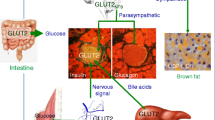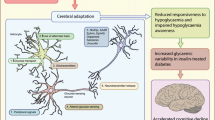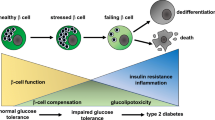Abstract
The effects of cholinergic stimulation on beta cell insulin secretory and phosphoinositide (PI) responses were determined in freshly isolated rat islets. Increasing the glucose level perifusing the islet from 5.6 to 8 mM was accompanied by a modest insulin secretory response. The further addition of 10 μM carbachol increased peak first- and second-phase responses by 2.6- and 6.8-fold, respectively. In the presence of 5.6 mM glucose, this low level (10 μM) of carbachol increased insulin release two-to three-fold, a response that was maintained for at least 60 min. In contrast to these acute stimulatory actions in the presence of glucose, chronic 3.5-h exposure of islets to 10 μM carbachol abolished beta cell insulin secretory responses to stimulation, with the combination of 8 mM glucose plus 10 μM carbachol. However, the further addition of 200 μM tolbutamide to these islets increased insulin secretory rates significantly. To establish the role of islet cell PI hydrolysis in these secretory responses, additional studies were conducted with islets whose PI pools were labeled with [3H]inositol. Acute exposure to 10 μM carbachol alone significantly increased inositol phosphate accumulation and the efflux of [3H]inositol, even in the absence of glucose. Including 10 μM carbachol during the labeling period with [3H]inositol resulted in significant impairments in subsequently measured inositol phosphate accumulation and [3H]inositol efflux responses to 8 mM glucose plus carbachol stimulation. Prior long-term exposure to 10 μM carbachol also induced heterologous desensitization: 20 mM glucose-stimulated insulin release and inositol phosphate accumulation were impaired in a parallel fashion. Chronic carbachol exposure had no deleterious effect on the usage of 8 or 20 mM glucose or on the insulin content of the islet. The acute stimulatory effects of carbachol on inositol phosphate accumulation as well as its inhibitory effect on 20 mM glucose-stimulated insulin release after prolonged exposure to the muscarinic agonist were significantly reduced by atropine. These findings demonstrate that changes in PI hydrolysis parallel those observed with insulin secretion and suggest that alterations in phospholipase C activation may account, at least in part, for the insulin secretory responses observed.
Similar content being viewed by others
References
Berthoud H-R, Jeanrenaud B (1979) Acute hyperinsulinemia and its reversal by vagotomy after lesions of the ventromedial hypothalamus in anesthetized rats. Endocrinology 105:146–151
Best L, Malaisse WJ (1983) Stimulation of phosphoinositide breakdown in pancreatic islets by glucose and carbamylcholine. Biochem Biophys Res Commun 116:9–16
Bolaffi JL, Bruno Z, Heldt A, Grodsky GM (1988) Characteristics of desensitization of insulin secretion in fully in vitro systems. Endocrinology 122:1801–1809
Bolaffi JL, Rodd GG, Ma YH, Bright D, Grodsky GM (1991) The role of Ca2+-related events in glucose-stimulated desensitization of insulin secretion. Endocrinology 129:2131–2138
DeFronzo RA, Bonadonna RC, Ferrannini E (1992) Pathogenesis of NIDDM: a balanced overview. Diabetes Care 15:318–368
Griendling KK, Rittenhouse SE, Brock TA, Ekstein LS, Gimbrone MAJ, Alexander RW(1986) Sustained diacylglycerol formation from inositol phospholipids in angiotensin II-stimulated vascular smooth muscle cells. J Biol Chem 261:5901–5906
Grodsky GM (1989) A new phase of insulin secretion. How will it contribute to our understanding of β-cell function? Diabetes 38:673–678
Hepler JR, Jeffs RA, Huckle WR, Outlaw HE, Rhee SG, Earp HS, Harden TK (1990) Evidence that the epidermal growth factor receptor and non-tyrosine kinase hormone receptors stimulate phosphoinositide hydrolysis by independent pathways. Biochem J 270:337–344
Hermansen K (1984) Effects of cholecystokinin (CCK)-4, non-sulfated CCK-8, and sulfated CCK-8 on pancreatic somato-statin, insulin, and glucagon secretion in the dog: studies in vitro. Endocrinology 114:1770–1775
Huckle WR, Hepler JR, Rhee SG, Harden TK, Earp HS (1990) Protein kinase C inhibits epidermal growth factor-dependent tyrosine phosphorylation of phospholipase Cγ and activation of phosphoinositide hydrolysis. Endocrinology 127:1697–1705
Imai A, Gershengorn MC (1986) Phosphatidylinositol 4,5-bis-phosphate turnover is transient while phosphatidylinositol turnover is persistent in thyrotropin-releasing hormone-stimulated rat pituitary cells. Proc. Nat Acad Sci USA 83:8540–8544
Kanety H, Moshe S, Shafrir E, Lunenfeld B, Karasik A (1994) Hyperinsulinemia induces a reversible impairment in insulin receptor function leading to diabetes in the sand rat model of non-insulin-dependent mellitus. Proc Natl Acad Sci USA 91:1853–1857
Kelley GG, Zawalich KC, Zawalich WS (1995) Synergistic interaction of glucose and neurohumoral agonists to stimulate islet phosphoinositide hydrolysis. Am J Physiol 269:E575-E582
LeStunff C, Borgnères P (1994) Early changes in postprandial insulin secretion, not in insulin sensitivity, characterize juvenile obesity. Diabetes 43:696–702
Loubatieres-Mariani MM, Chapal J, Alric R, Loubatieres A (1973) Studies of the cholinergic receptor involved in the secretion of insulin using isolated perfused rat pancreas. Diabetologia 9:439–476
Louis-Sylvestre J (1978) Relationships between the two stages of prandial insulin release in rats. Am J Physiol 235:E103-E111
Majerus PW, Connolly TM, Bansal VS, Inhorn RC, Ross TS, Lips DL (1988) Inositol phosphates: synthesis and degradation. J Biol Chem 263:3051–3054
Mojsov S, Weir GC, Habener JF (1987) Insulinotropin: glucagon-like peptide (7–37) co-encoded in the glucagon gene is a potent stimulator of insulin release in the perfused rat pancreas. J Clin Invest 79:616–619
Morgan NG, Rumford GM, Montague W (1985) Studies on the role of inositol trisphosphate in the regulation of insulin secretion from isolated rat islets of Langerhans. Biochem J 228:713–718
Nishizuka Y (1985) Turnover of inositol phospholipids and signal transduction. Science 225:1365–1370
Parra-Covarrubias A, Rivera-Rodriguez I, Almaraz-Ugalde A (1971) Cephalic phase of insulin secretion in obese adolescents. Diabetes 20:800–802
Rohner-Jeanrenaud F, Jeanrenaud B (1981) Possible involvement of the cholinergic system in hormonal secretion by the perfused pancreas from ventromedial-hypothalamic lesioned rats. Diabetologia 20:217–222
Rohner-Jeanrenaud F, Jeanrenaud B (1985) A role for the vagus nerve in the etiology and maintenance of the hyperinsu-linemia of genetically obese fa/fa rats. Int J Obes 9:71–75
Rohner-Jeanrenaud F, Hochstrasser A-C, Jeanrenaud B (1983) Hyperinsulinemia of preobese and obese fa/fa rats is partly vagus nerve mediated. Am J Physiol 244:E317-E322
Szecowka J, Lins PE, Efendic S (1982) Effects of cholecys-tokinin, gastric inhibitory polypeptide and secretin on insulin and glucagon secretion in rats. Endocrinology 110:1268–1272
Wollheim CB, Biden TJ (1986) Second messenger function of inositol 1,4,5-trisphosphate. J Biol Chem 261:8314–8319
Zawalich WS, Zawalich KC (1988) Phosphoinositide hydrolysis and insulin release from isolated perifused rat islets. Studies with glucose. Diabetes 37:1294–1300
Zawalich WS, Rognstad R, Pagliara AS, Matschinsky FM (1977) A comparison of the utilization rates and hormone-releasing actions of glucose, mannose, and fructose in isolated pancreatic islets. J Biol Chem 252:8519–8523
Zawalich WS, Zawalich KC, Rasmussen H (1989) Cholinergic agonists prime the β-cell to glucose stimulation. Endocrinology 125:2400–2406
Zawalich WS, Zawalich KC, Rasmussen H (1989) The conditions under which rat islets are labelled with [3H]inositol alter the subsequent responses of these islets to a high glucose concentration. Biochem J 259:743–749
Author information
Authors and Affiliations
Rights and permissions
About this article
Cite this article
Zawalich, W.S., Zawalich, K.C. & Kelley, G.G. Time-dependent effects of cholinergic stimulation on beta cell responsiveness. Pflügers Arch. 432, 589–596 (1996). https://doi.org/10.1007/s004240050174
Received:
Revised:
Accepted:
Published:
Issue Date:
DOI: https://doi.org/10.1007/s004240050174




